Allowable Deductions for Legal Expenses
VerifiedAdded on 2019/11/12
|12
|1786
|370
Essay
AI Summary
The assignment content is related to income tax assessment and goods and service taxation in Australia. It involves the application of Section 8-1 of the Income Tax Assessment Act 1997, which deals with allowable deductions for business purposes, and Goods and Service Tax (GST) legislation, particularly GSTR Act 1999 and rulings such as GSTR 2006/3. The main issues discussed are determining input tax credit for Big Bank Limited regarding advertisement expenses under GST and identifying the criteria for claiming input tax credit.
Contribute Materials
Your contribution can guide someone’s learning journey. Share your
documents today.
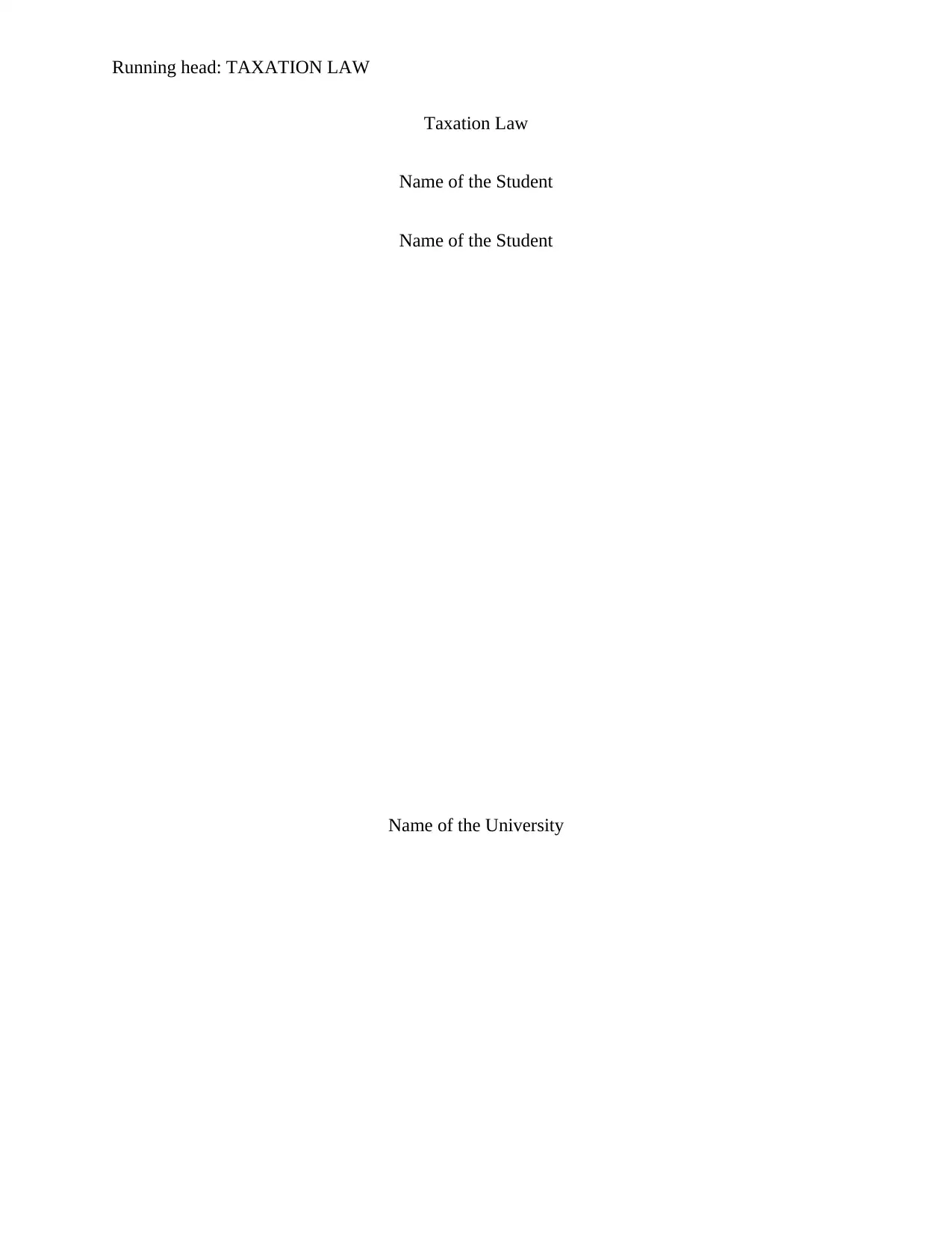
Running head: TAXATION LAW
Taxation Law
Name of the Student
Name of the Student
Name of the University
Taxation Law
Name of the Student
Name of the Student
Name of the University
Secure Best Marks with AI Grader
Need help grading? Try our AI Grader for instant feedback on your assignments.
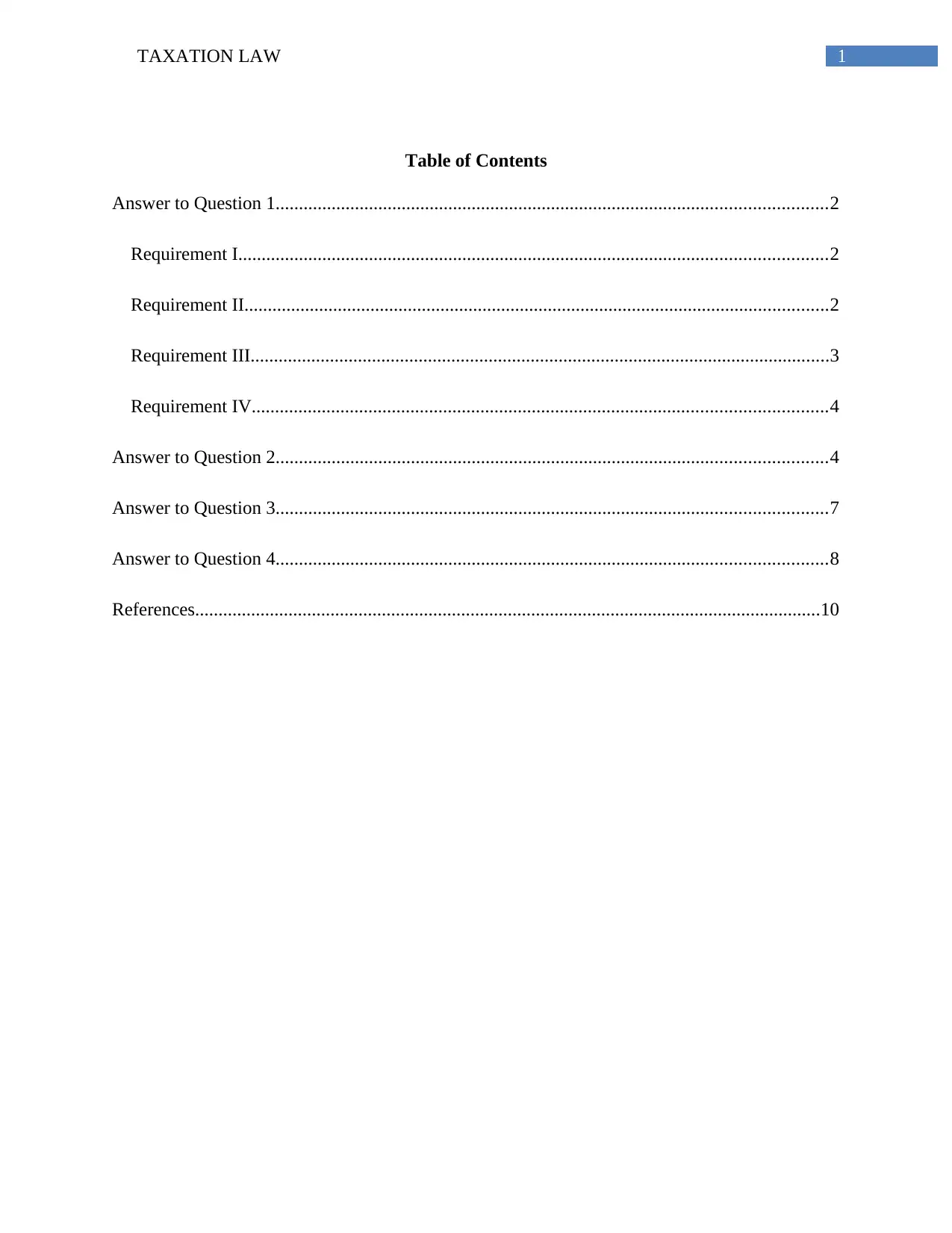
1TAXATION LAW
Table of Contents
Answer to Question 1......................................................................................................................2
Requirement I..............................................................................................................................2
Requirement II.............................................................................................................................2
Requirement III............................................................................................................................3
Requirement IV...........................................................................................................................4
Answer to Question 2......................................................................................................................4
Answer to Question 3......................................................................................................................7
Answer to Question 4......................................................................................................................8
References......................................................................................................................................10
Table of Contents
Answer to Question 1......................................................................................................................2
Requirement I..............................................................................................................................2
Requirement II.............................................................................................................................2
Requirement III............................................................................................................................3
Requirement IV...........................................................................................................................4
Answer to Question 2......................................................................................................................4
Answer to Question 3......................................................................................................................7
Answer to Question 4......................................................................................................................8
References......................................................................................................................................10
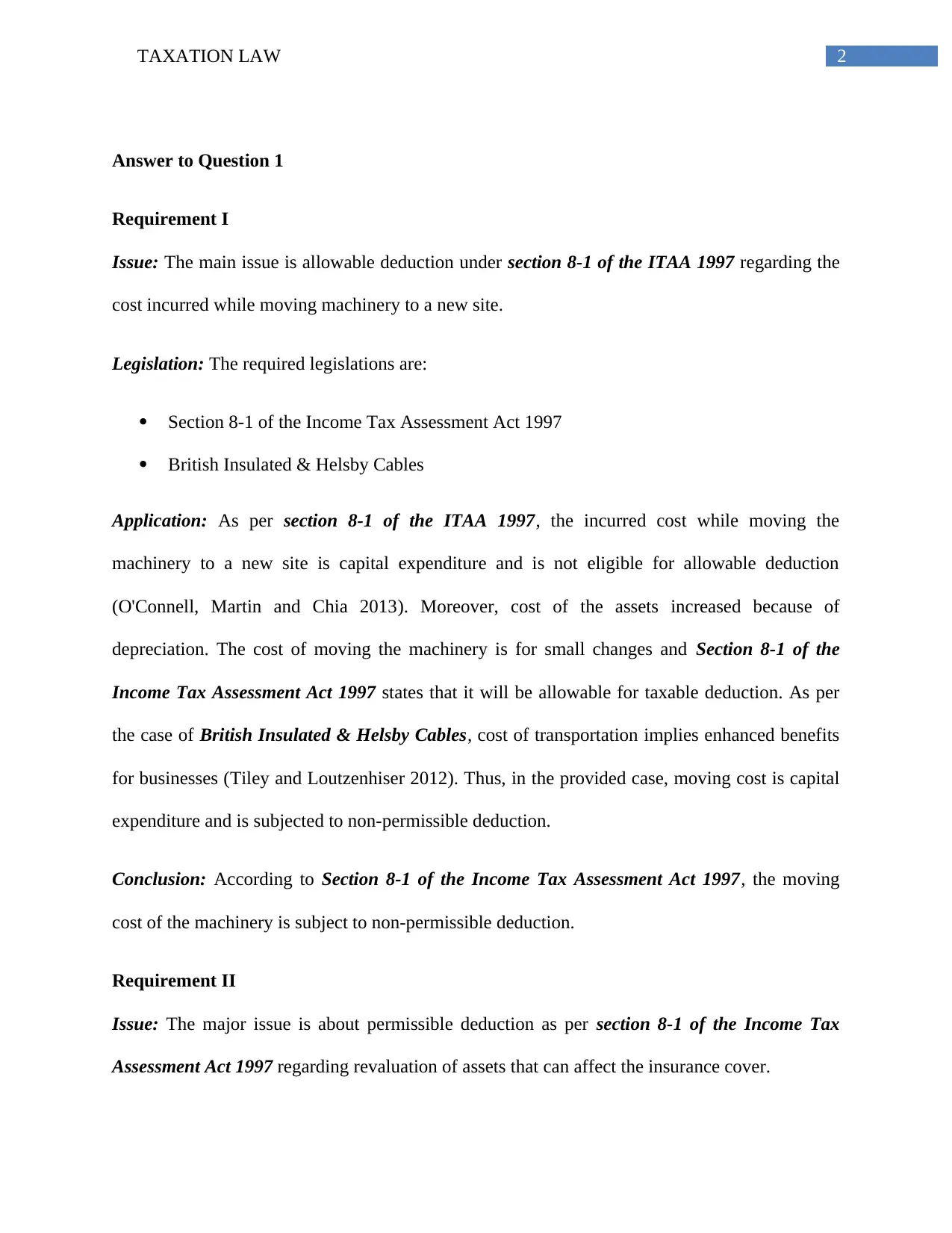
2TAXATION LAW
Answer to Question 1
Requirement I
Issue: The main issue is allowable deduction under section 8-1 of the ITAA 1997 regarding the
cost incurred while moving machinery to a new site.
Legislation: The required legislations are:
Section 8-1 of the Income Tax Assessment Act 1997
British Insulated & Helsby Cables
Application: As per section 8-1 of the ITAA 1997, the incurred cost while moving the
machinery to a new site is capital expenditure and is not eligible for allowable deduction
(O'Connell, Martin and Chia 2013). Moreover, cost of the assets increased because of
depreciation. The cost of moving the machinery is for small changes and Section 8-1 of the
Income Tax Assessment Act 1997 states that it will be allowable for taxable deduction. As per
the case of British Insulated & Helsby Cables, cost of transportation implies enhanced benefits
for businesses (Tiley and Loutzenhiser 2012). Thus, in the provided case, moving cost is capital
expenditure and is subjected to non-permissible deduction.
Conclusion: According to Section 8-1 of the Income Tax Assessment Act 1997, the moving
cost of the machinery is subject to non-permissible deduction.
Requirement II
Issue: The major issue is about permissible deduction as per section 8-1 of the Income Tax
Assessment Act 1997 regarding revaluation of assets that can affect the insurance cover.
Answer to Question 1
Requirement I
Issue: The main issue is allowable deduction under section 8-1 of the ITAA 1997 regarding the
cost incurred while moving machinery to a new site.
Legislation: The required legislations are:
Section 8-1 of the Income Tax Assessment Act 1997
British Insulated & Helsby Cables
Application: As per section 8-1 of the ITAA 1997, the incurred cost while moving the
machinery to a new site is capital expenditure and is not eligible for allowable deduction
(O'Connell, Martin and Chia 2013). Moreover, cost of the assets increased because of
depreciation. The cost of moving the machinery is for small changes and Section 8-1 of the
Income Tax Assessment Act 1997 states that it will be allowable for taxable deduction. As per
the case of British Insulated & Helsby Cables, cost of transportation implies enhanced benefits
for businesses (Tiley and Loutzenhiser 2012). Thus, in the provided case, moving cost is capital
expenditure and is subjected to non-permissible deduction.
Conclusion: According to Section 8-1 of the Income Tax Assessment Act 1997, the moving
cost of the machinery is subject to non-permissible deduction.
Requirement II
Issue: The major issue is about permissible deduction as per section 8-1 of the Income Tax
Assessment Act 1997 regarding revaluation of assets that can affect the insurance cover.
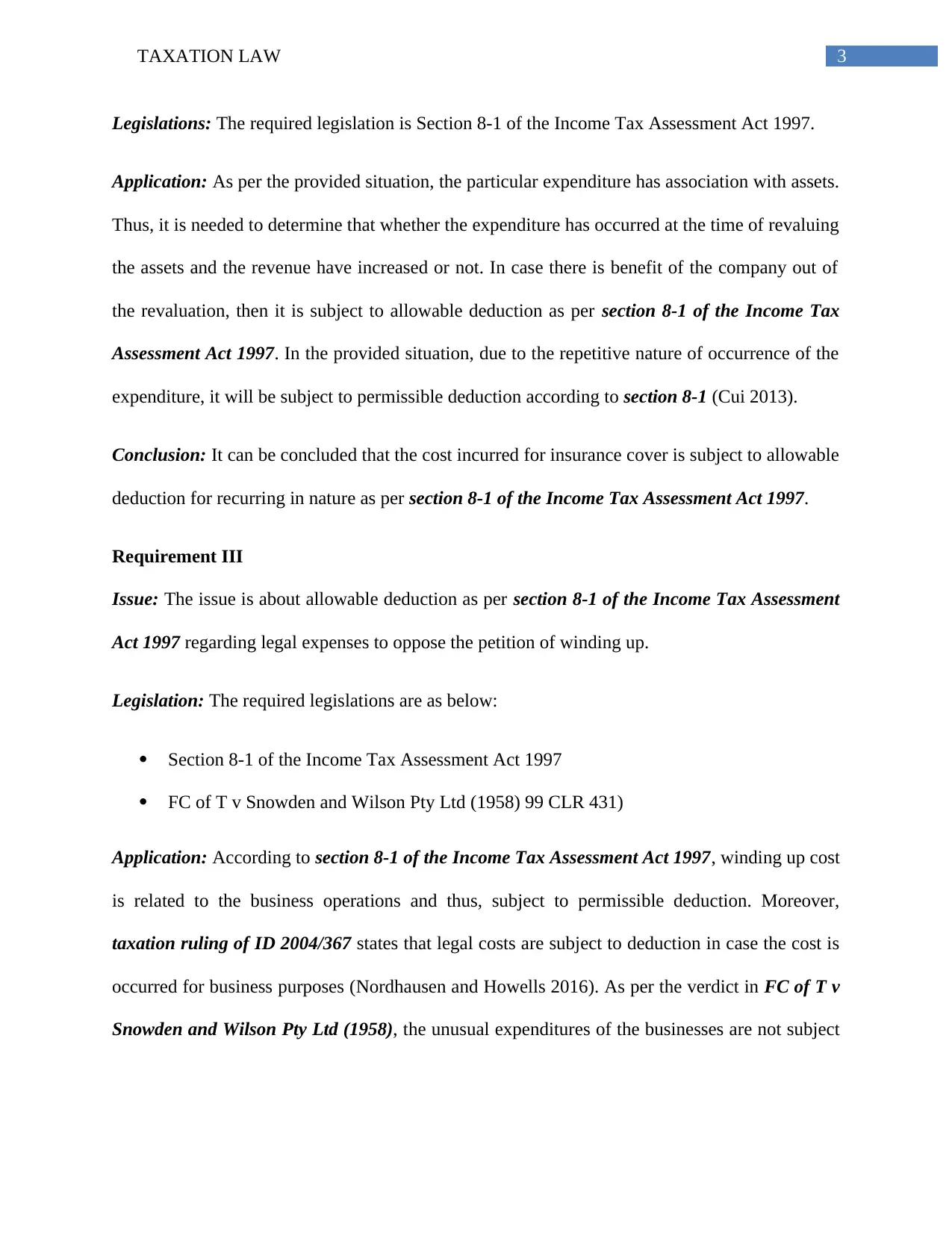
3TAXATION LAW
Legislations: The required legislation is Section 8-1 of the Income Tax Assessment Act 1997.
Application: As per the provided situation, the particular expenditure has association with assets.
Thus, it is needed to determine that whether the expenditure has occurred at the time of revaluing
the assets and the revenue have increased or not. In case there is benefit of the company out of
the revaluation, then it is subject to allowable deduction as per section 8-1 of the Income Tax
Assessment Act 1997. In the provided situation, due to the repetitive nature of occurrence of the
expenditure, it will be subject to permissible deduction according to section 8-1 (Cui 2013).
Conclusion: It can be concluded that the cost incurred for insurance cover is subject to allowable
deduction for recurring in nature as per section 8-1 of the Income Tax Assessment Act 1997.
Requirement III
Issue: The issue is about allowable deduction as per section 8-1 of the Income Tax Assessment
Act 1997 regarding legal expenses to oppose the petition of winding up.
Legislation: The required legislations are as below:
Section 8-1 of the Income Tax Assessment Act 1997
FC of T v Snowden and Wilson Pty Ltd (1958) 99 CLR 431)
Application: According to section 8-1 of the Income Tax Assessment Act 1997, winding up cost
is related to the business operations and thus, subject to permissible deduction. Moreover,
taxation ruling of ID 2004/367 states that legal costs are subject to deduction in case the cost is
occurred for business purposes (Nordhausen and Howells 2016). As per the verdict in FC of T v
Snowden and Wilson Pty Ltd (1958), the unusual expenditures of the businesses are not subject
Legislations: The required legislation is Section 8-1 of the Income Tax Assessment Act 1997.
Application: As per the provided situation, the particular expenditure has association with assets.
Thus, it is needed to determine that whether the expenditure has occurred at the time of revaluing
the assets and the revenue have increased or not. In case there is benefit of the company out of
the revaluation, then it is subject to allowable deduction as per section 8-1 of the Income Tax
Assessment Act 1997. In the provided situation, due to the repetitive nature of occurrence of the
expenditure, it will be subject to permissible deduction according to section 8-1 (Cui 2013).
Conclusion: It can be concluded that the cost incurred for insurance cover is subject to allowable
deduction for recurring in nature as per section 8-1 of the Income Tax Assessment Act 1997.
Requirement III
Issue: The issue is about allowable deduction as per section 8-1 of the Income Tax Assessment
Act 1997 regarding legal expenses to oppose the petition of winding up.
Legislation: The required legislations are as below:
Section 8-1 of the Income Tax Assessment Act 1997
FC of T v Snowden and Wilson Pty Ltd (1958) 99 CLR 431)
Application: According to section 8-1 of the Income Tax Assessment Act 1997, winding up cost
is related to the business operations and thus, subject to permissible deduction. Moreover,
taxation ruling of ID 2004/367 states that legal costs are subject to deduction in case the cost is
occurred for business purposes (Nordhausen and Howells 2016). As per the verdict in FC of T v
Snowden and Wilson Pty Ltd (1958), the unusual expenditures of the businesses are not subject
Secure Best Marks with AI Grader
Need help grading? Try our AI Grader for instant feedback on your assignments.
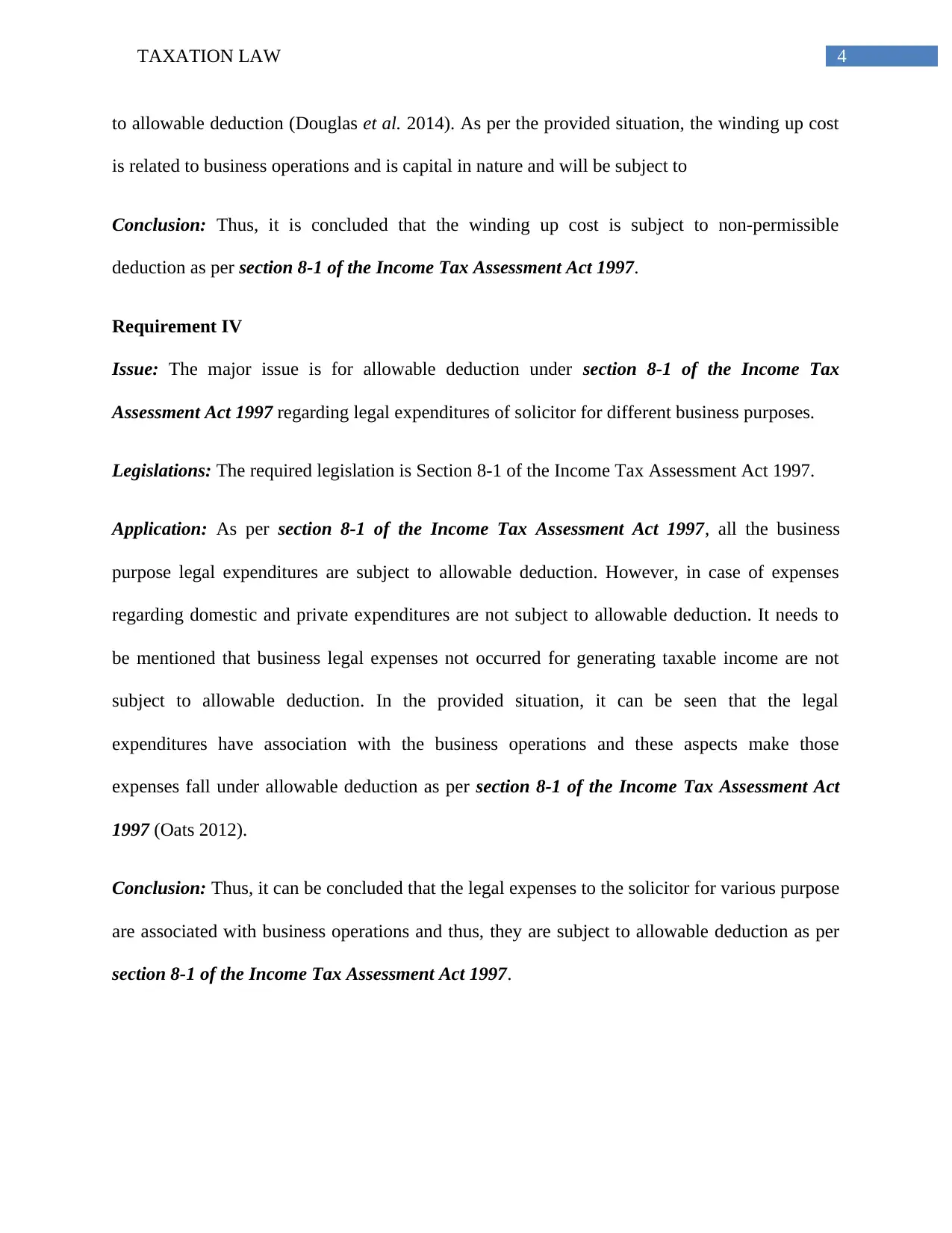
4TAXATION LAW
to allowable deduction (Douglas et al. 2014). As per the provided situation, the winding up cost
is related to business operations and is capital in nature and will be subject to
Conclusion: Thus, it is concluded that the winding up cost is subject to non-permissible
deduction as per section 8-1 of the Income Tax Assessment Act 1997.
Requirement IV
Issue: The major issue is for allowable deduction under section 8-1 of the Income Tax
Assessment Act 1997 regarding legal expenditures of solicitor for different business purposes.
Legislations: The required legislation is Section 8-1 of the Income Tax Assessment Act 1997.
Application: As per section 8-1 of the Income Tax Assessment Act 1997, all the business
purpose legal expenditures are subject to allowable deduction. However, in case of expenses
regarding domestic and private expenditures are not subject to allowable deduction. It needs to
be mentioned that business legal expenses not occurred for generating taxable income are not
subject to allowable deduction. In the provided situation, it can be seen that the legal
expenditures have association with the business operations and these aspects make those
expenses fall under allowable deduction as per section 8-1 of the Income Tax Assessment Act
1997 (Oats 2012).
Conclusion: Thus, it can be concluded that the legal expenses to the solicitor for various purpose
are associated with business operations and thus, they are subject to allowable deduction as per
section 8-1 of the Income Tax Assessment Act 1997.
to allowable deduction (Douglas et al. 2014). As per the provided situation, the winding up cost
is related to business operations and is capital in nature and will be subject to
Conclusion: Thus, it is concluded that the winding up cost is subject to non-permissible
deduction as per section 8-1 of the Income Tax Assessment Act 1997.
Requirement IV
Issue: The major issue is for allowable deduction under section 8-1 of the Income Tax
Assessment Act 1997 regarding legal expenditures of solicitor for different business purposes.
Legislations: The required legislation is Section 8-1 of the Income Tax Assessment Act 1997.
Application: As per section 8-1 of the Income Tax Assessment Act 1997, all the business
purpose legal expenditures are subject to allowable deduction. However, in case of expenses
regarding domestic and private expenditures are not subject to allowable deduction. It needs to
be mentioned that business legal expenses not occurred for generating taxable income are not
subject to allowable deduction. In the provided situation, it can be seen that the legal
expenditures have association with the business operations and these aspects make those
expenses fall under allowable deduction as per section 8-1 of the Income Tax Assessment Act
1997 (Oats 2012).
Conclusion: Thus, it can be concluded that the legal expenses to the solicitor for various purpose
are associated with business operations and thus, they are subject to allowable deduction as per
section 8-1 of the Income Tax Assessment Act 1997.
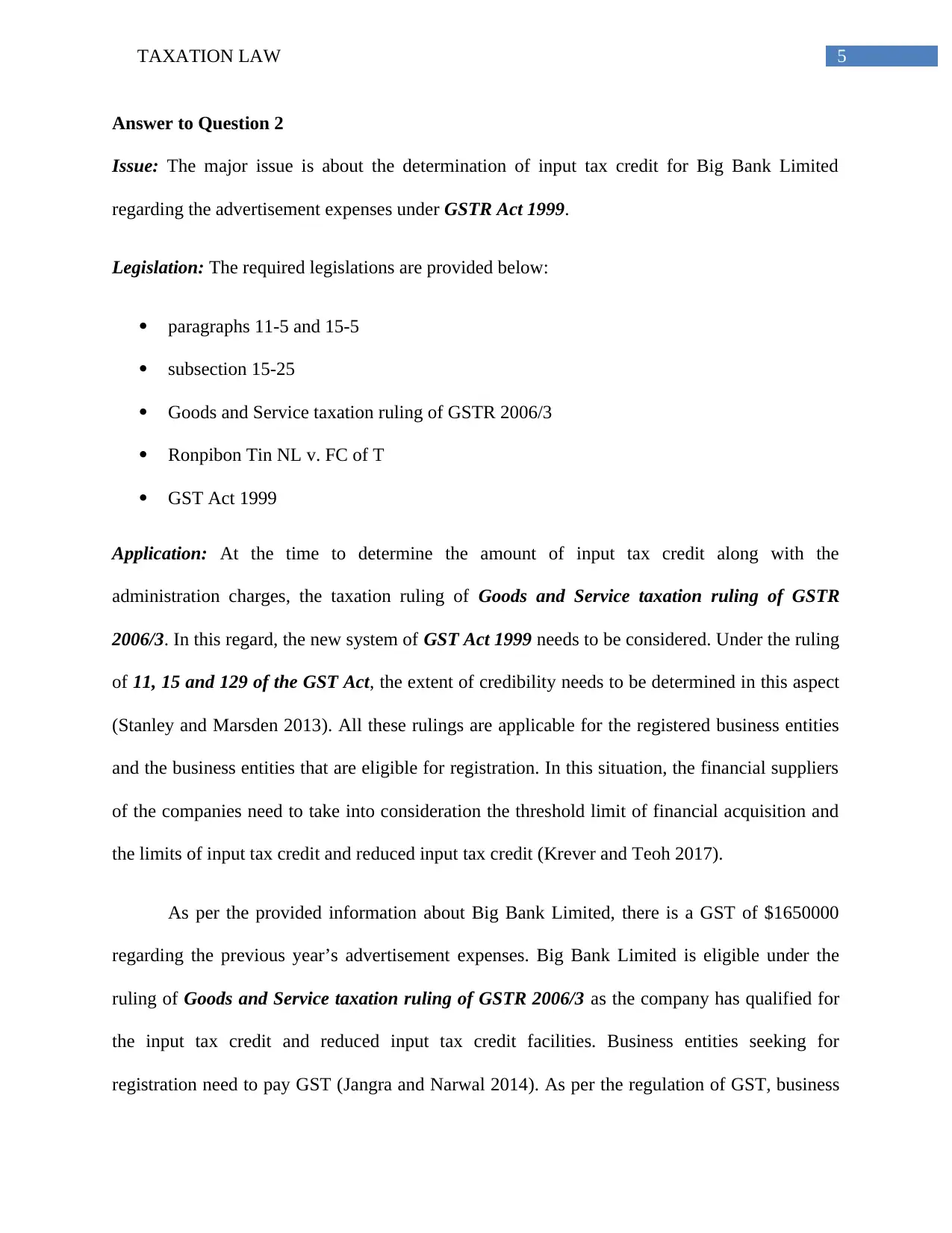
5TAXATION LAW
Answer to Question 2
Issue: The major issue is about the determination of input tax credit for Big Bank Limited
regarding the advertisement expenses under GSTR Act 1999.
Legislation: The required legislations are provided below:
paragraphs 11-5 and 15-5
subsection 15-25
Goods and Service taxation ruling of GSTR 2006/3
Ronpibon Tin NL v. FC of T
GST Act 1999
Application: At the time to determine the amount of input tax credit along with the
administration charges, the taxation ruling of Goods and Service taxation ruling of GSTR
2006/3. In this regard, the new system of GST Act 1999 needs to be considered. Under the ruling
of 11, 15 and 129 of the GST Act, the extent of credibility needs to be determined in this aspect
(Stanley and Marsden 2013). All these rulings are applicable for the registered business entities
and the business entities that are eligible for registration. In this situation, the financial suppliers
of the companies need to take into consideration the threshold limit of financial acquisition and
the limits of input tax credit and reduced input tax credit (Krever and Teoh 2017).
As per the provided information about Big Bank Limited, there is a GST of $1650000
regarding the previous year’s advertisement expenses. Big Bank Limited is eligible under the
ruling of Goods and Service taxation ruling of GSTR 2006/3 as the company has qualified for
the input tax credit and reduced input tax credit facilities. Business entities seeking for
registration need to pay GST (Jangra and Narwal 2014). As per the regulation of GST, business
Answer to Question 2
Issue: The major issue is about the determination of input tax credit for Big Bank Limited
regarding the advertisement expenses under GSTR Act 1999.
Legislation: The required legislations are provided below:
paragraphs 11-5 and 15-5
subsection 15-25
Goods and Service taxation ruling of GSTR 2006/3
Ronpibon Tin NL v. FC of T
GST Act 1999
Application: At the time to determine the amount of input tax credit along with the
administration charges, the taxation ruling of Goods and Service taxation ruling of GSTR
2006/3. In this regard, the new system of GST Act 1999 needs to be considered. Under the ruling
of 11, 15 and 129 of the GST Act, the extent of credibility needs to be determined in this aspect
(Stanley and Marsden 2013). All these rulings are applicable for the registered business entities
and the business entities that are eligible for registration. In this situation, the financial suppliers
of the companies need to take into consideration the threshold limit of financial acquisition and
the limits of input tax credit and reduced input tax credit (Krever and Teoh 2017).
As per the provided information about Big Bank Limited, there is a GST of $1650000
regarding the previous year’s advertisement expenses. Big Bank Limited is eligible under the
ruling of Goods and Service taxation ruling of GSTR 2006/3 as the company has qualified for
the input tax credit and reduced input tax credit facilities. Business entities seeking for
registration need to pay GST (Jangra and Narwal 2014). As per the regulation of GST, business
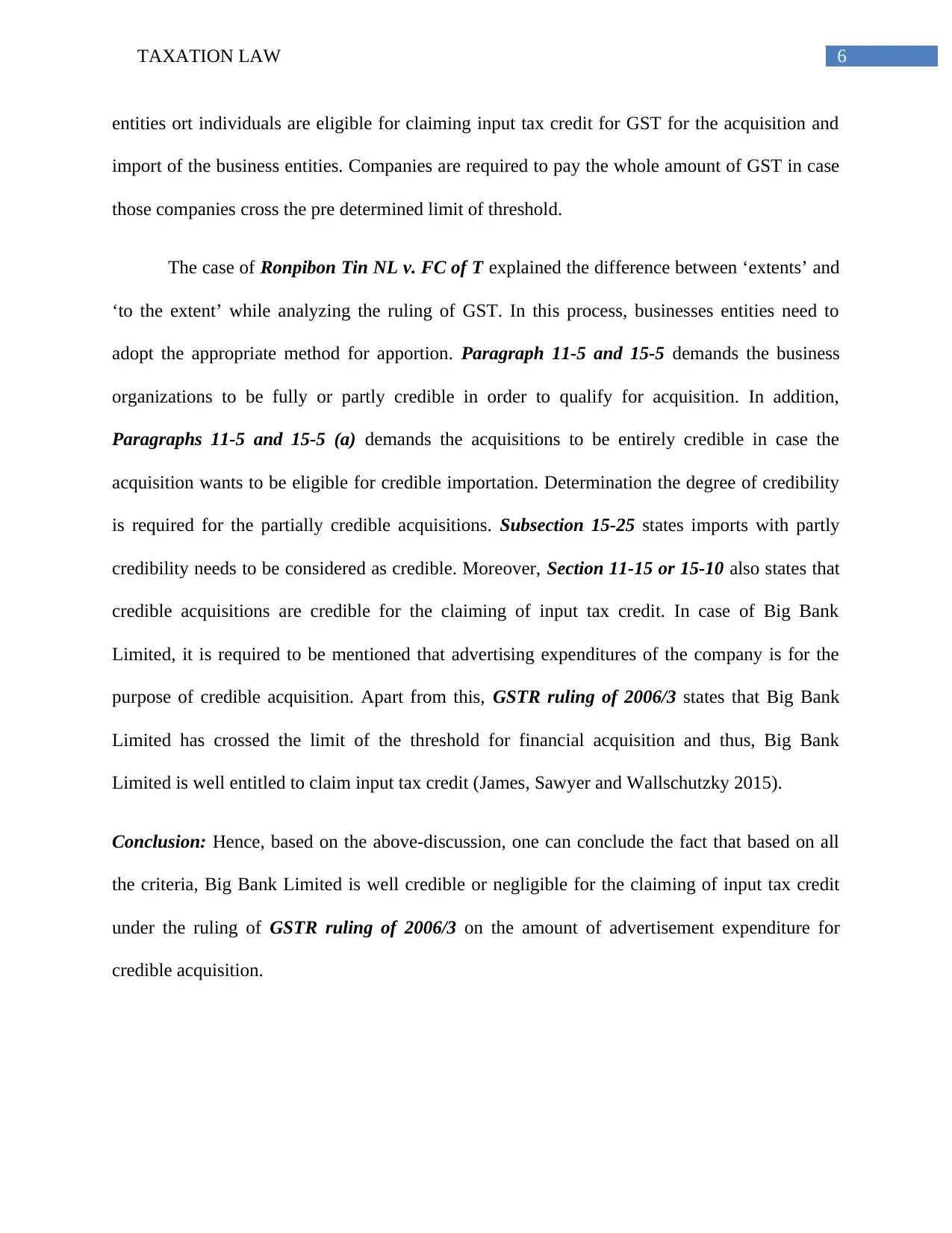
6TAXATION LAW
entities ort individuals are eligible for claiming input tax credit for GST for the acquisition and
import of the business entities. Companies are required to pay the whole amount of GST in case
those companies cross the pre determined limit of threshold.
The case of Ronpibon Tin NL v. FC of T explained the difference between ‘extents’ and
‘to the extent’ while analyzing the ruling of GST. In this process, businesses entities need to
adopt the appropriate method for apportion. Paragraph 11-5 and 15-5 demands the business
organizations to be fully or partly credible in order to qualify for acquisition. In addition,
Paragraphs 11-5 and 15-5 (a) demands the acquisitions to be entirely credible in case the
acquisition wants to be eligible for credible importation. Determination the degree of credibility
is required for the partially credible acquisitions. Subsection 15-25 states imports with partly
credibility needs to be considered as credible. Moreover, Section 11-15 or 15-10 also states that
credible acquisitions are credible for the claiming of input tax credit. In case of Big Bank
Limited, it is required to be mentioned that advertising expenditures of the company is for the
purpose of credible acquisition. Apart from this, GSTR ruling of 2006/3 states that Big Bank
Limited has crossed the limit of the threshold for financial acquisition and thus, Big Bank
Limited is well entitled to claim input tax credit (James, Sawyer and Wallschutzky 2015).
Conclusion: Hence, based on the above-discussion, one can conclude the fact that based on all
the criteria, Big Bank Limited is well credible or negligible for the claiming of input tax credit
under the ruling of GSTR ruling of 2006/3 on the amount of advertisement expenditure for
credible acquisition.
entities ort individuals are eligible for claiming input tax credit for GST for the acquisition and
import of the business entities. Companies are required to pay the whole amount of GST in case
those companies cross the pre determined limit of threshold.
The case of Ronpibon Tin NL v. FC of T explained the difference between ‘extents’ and
‘to the extent’ while analyzing the ruling of GST. In this process, businesses entities need to
adopt the appropriate method for apportion. Paragraph 11-5 and 15-5 demands the business
organizations to be fully or partly credible in order to qualify for acquisition. In addition,
Paragraphs 11-5 and 15-5 (a) demands the acquisitions to be entirely credible in case the
acquisition wants to be eligible for credible importation. Determination the degree of credibility
is required for the partially credible acquisitions. Subsection 15-25 states imports with partly
credibility needs to be considered as credible. Moreover, Section 11-15 or 15-10 also states that
credible acquisitions are credible for the claiming of input tax credit. In case of Big Bank
Limited, it is required to be mentioned that advertising expenditures of the company is for the
purpose of credible acquisition. Apart from this, GSTR ruling of 2006/3 states that Big Bank
Limited has crossed the limit of the threshold for financial acquisition and thus, Big Bank
Limited is well entitled to claim input tax credit (James, Sawyer and Wallschutzky 2015).
Conclusion: Hence, based on the above-discussion, one can conclude the fact that based on all
the criteria, Big Bank Limited is well credible or negligible for the claiming of input tax credit
under the ruling of GSTR ruling of 2006/3 on the amount of advertisement expenditure for
credible acquisition.
Paraphrase This Document
Need a fresh take? Get an instant paraphrase of this document with our AI Paraphraser
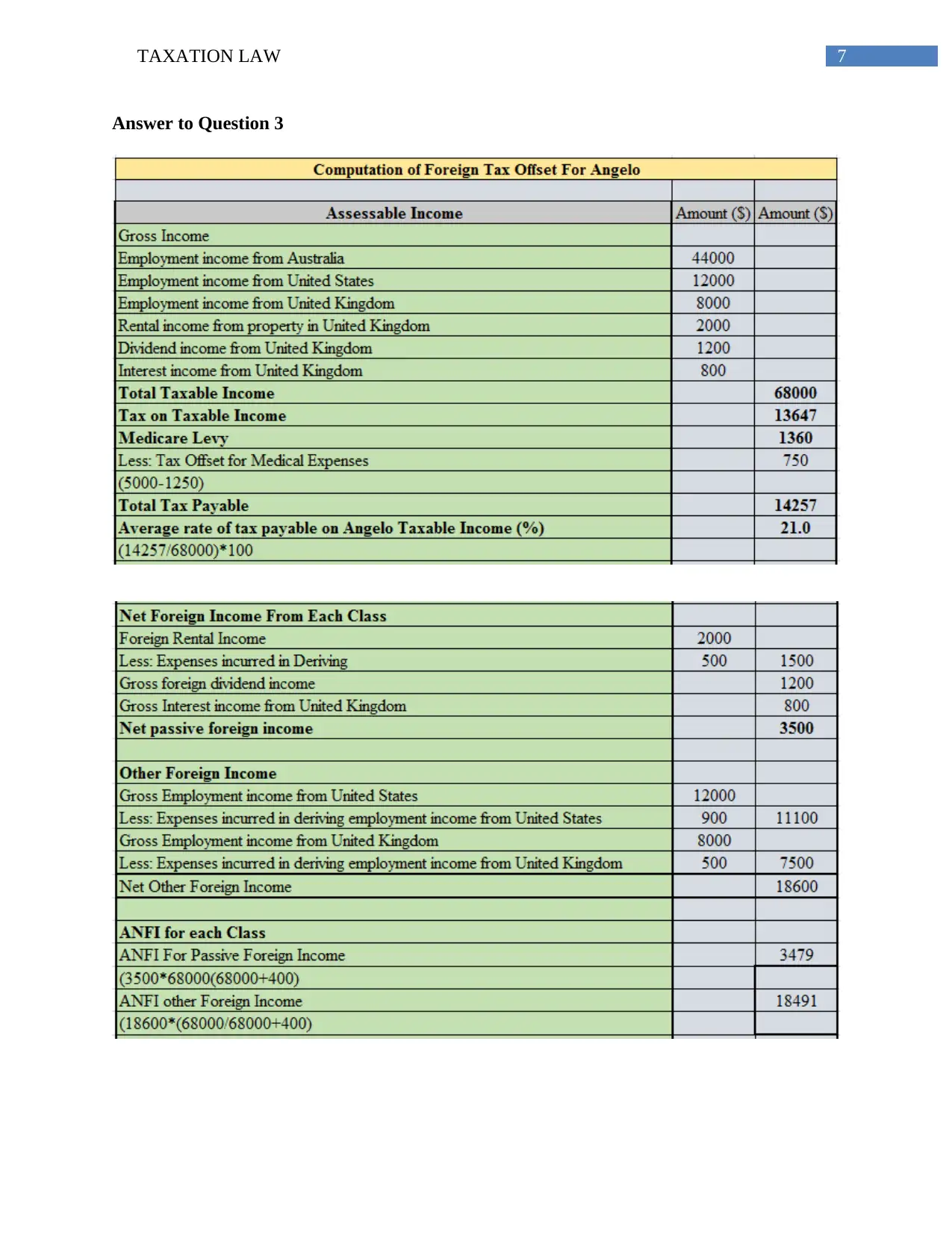
7TAXATION LAW
Answer to Question 3
Answer to Question 3
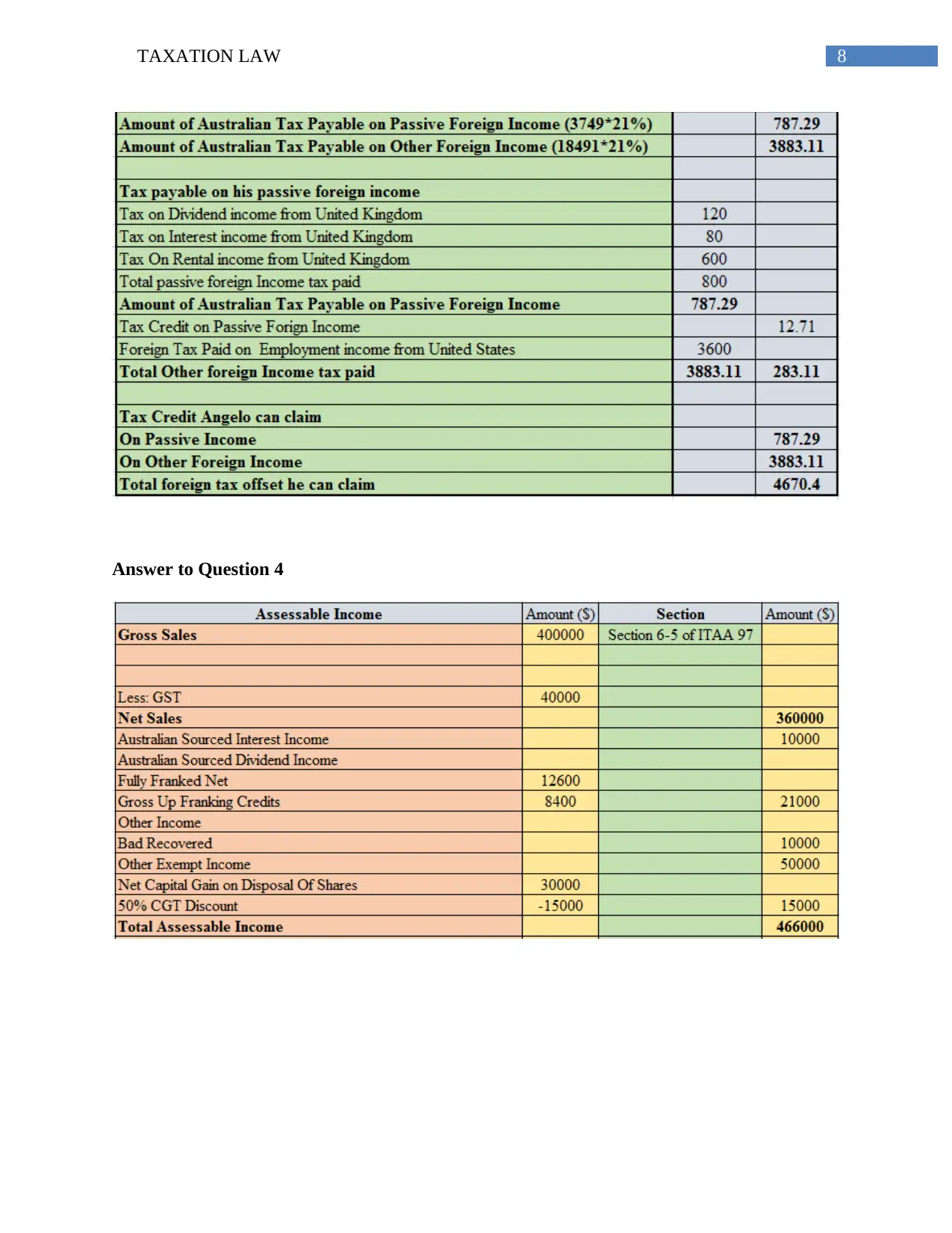
8TAXATION LAW
Answer to Question 4
Answer to Question 4
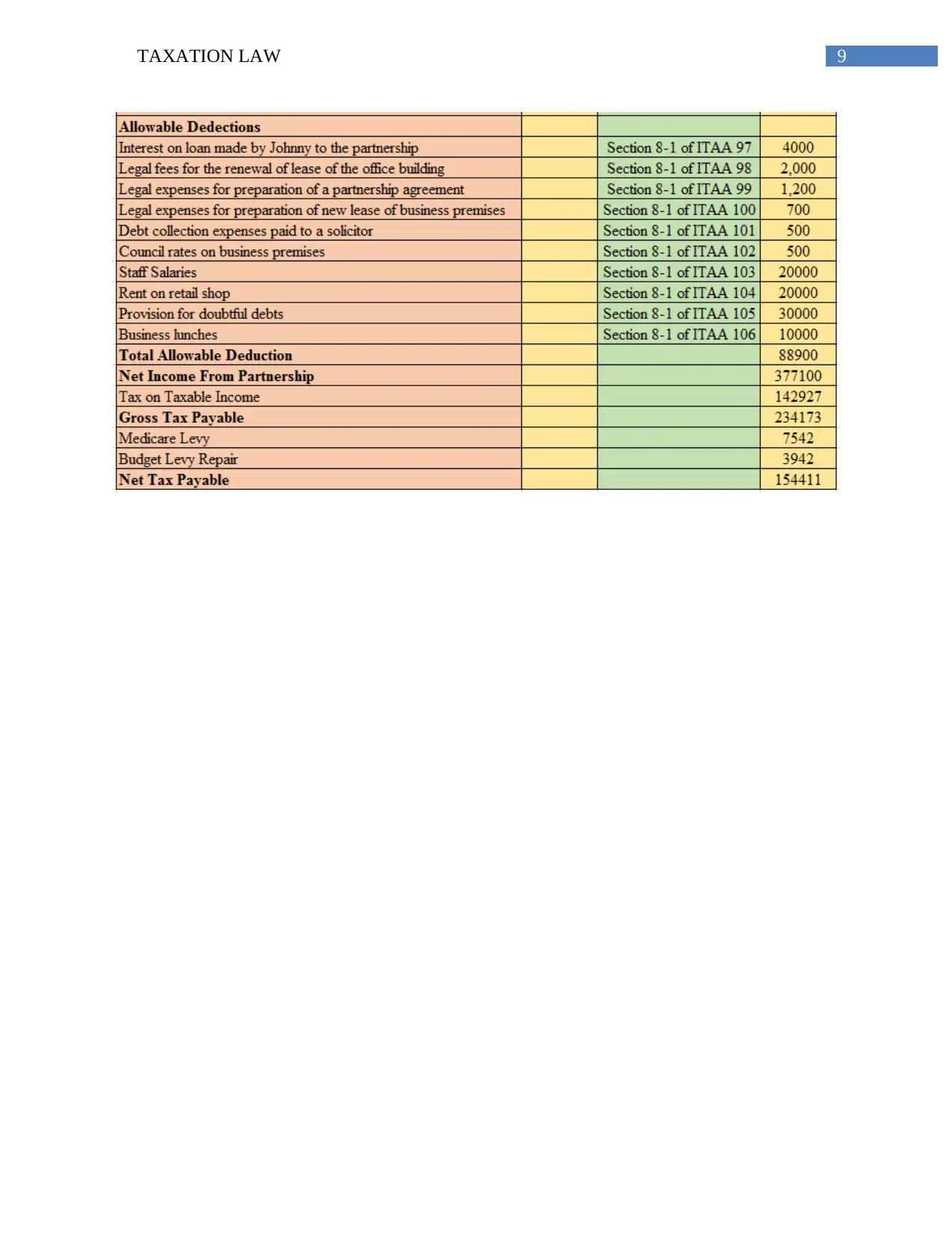
9TAXATION LAW
Secure Best Marks with AI Grader
Need help grading? Try our AI Grader for instant feedback on your assignments.
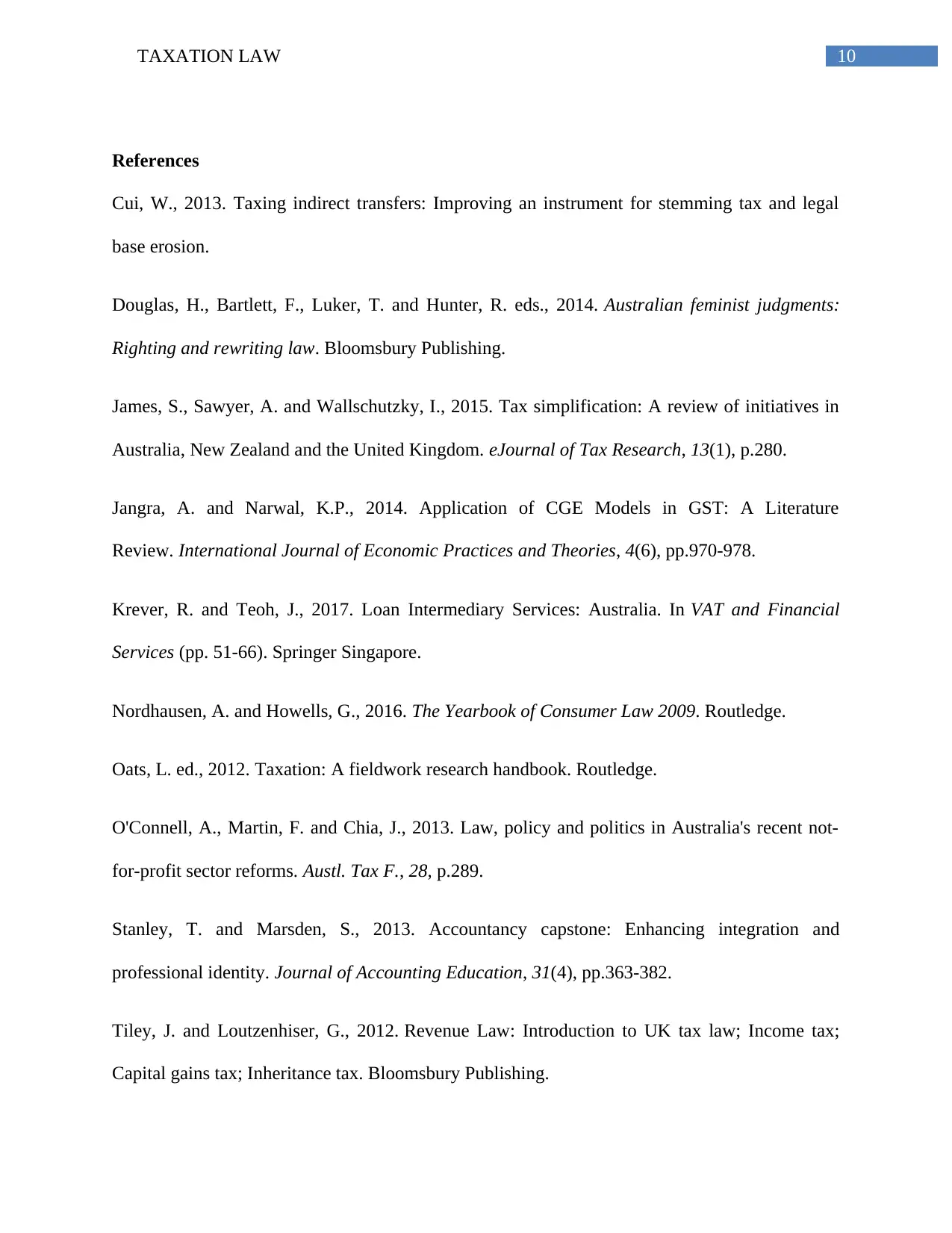
10TAXATION LAW
References
Cui, W., 2013. Taxing indirect transfers: Improving an instrument for stemming tax and legal
base erosion.
Douglas, H., Bartlett, F., Luker, T. and Hunter, R. eds., 2014. Australian feminist judgments:
Righting and rewriting law. Bloomsbury Publishing.
James, S., Sawyer, A. and Wallschutzky, I., 2015. Tax simplification: A review of initiatives in
Australia, New Zealand and the United Kingdom. eJournal of Tax Research, 13(1), p.280.
Jangra, A. and Narwal, K.P., 2014. Application of CGE Models in GST: A Literature
Review. International Journal of Economic Practices and Theories, 4(6), pp.970-978.
Krever, R. and Teoh, J., 2017. Loan Intermediary Services: Australia. In VAT and Financial
Services (pp. 51-66). Springer Singapore.
Nordhausen, A. and Howells, G., 2016. The Yearbook of Consumer Law 2009. Routledge.
Oats, L. ed., 2012. Taxation: A fieldwork research handbook. Routledge.
O'Connell, A., Martin, F. and Chia, J., 2013. Law, policy and politics in Australia's recent not-
for-profit sector reforms. Austl. Tax F., 28, p.289.
Stanley, T. and Marsden, S., 2013. Accountancy capstone: Enhancing integration and
professional identity. Journal of Accounting Education, 31(4), pp.363-382.
Tiley, J. and Loutzenhiser, G., 2012. Revenue Law: Introduction to UK tax law; Income tax;
Capital gains tax; Inheritance tax. Bloomsbury Publishing.
References
Cui, W., 2013. Taxing indirect transfers: Improving an instrument for stemming tax and legal
base erosion.
Douglas, H., Bartlett, F., Luker, T. and Hunter, R. eds., 2014. Australian feminist judgments:
Righting and rewriting law. Bloomsbury Publishing.
James, S., Sawyer, A. and Wallschutzky, I., 2015. Tax simplification: A review of initiatives in
Australia, New Zealand and the United Kingdom. eJournal of Tax Research, 13(1), p.280.
Jangra, A. and Narwal, K.P., 2014. Application of CGE Models in GST: A Literature
Review. International Journal of Economic Practices and Theories, 4(6), pp.970-978.
Krever, R. and Teoh, J., 2017. Loan Intermediary Services: Australia. In VAT and Financial
Services (pp. 51-66). Springer Singapore.
Nordhausen, A. and Howells, G., 2016. The Yearbook of Consumer Law 2009. Routledge.
Oats, L. ed., 2012. Taxation: A fieldwork research handbook. Routledge.
O'Connell, A., Martin, F. and Chia, J., 2013. Law, policy and politics in Australia's recent not-
for-profit sector reforms. Austl. Tax F., 28, p.289.
Stanley, T. and Marsden, S., 2013. Accountancy capstone: Enhancing integration and
professional identity. Journal of Accounting Education, 31(4), pp.363-382.
Tiley, J. and Loutzenhiser, G., 2012. Revenue Law: Introduction to UK tax law; Income tax;
Capital gains tax; Inheritance tax. Bloomsbury Publishing.
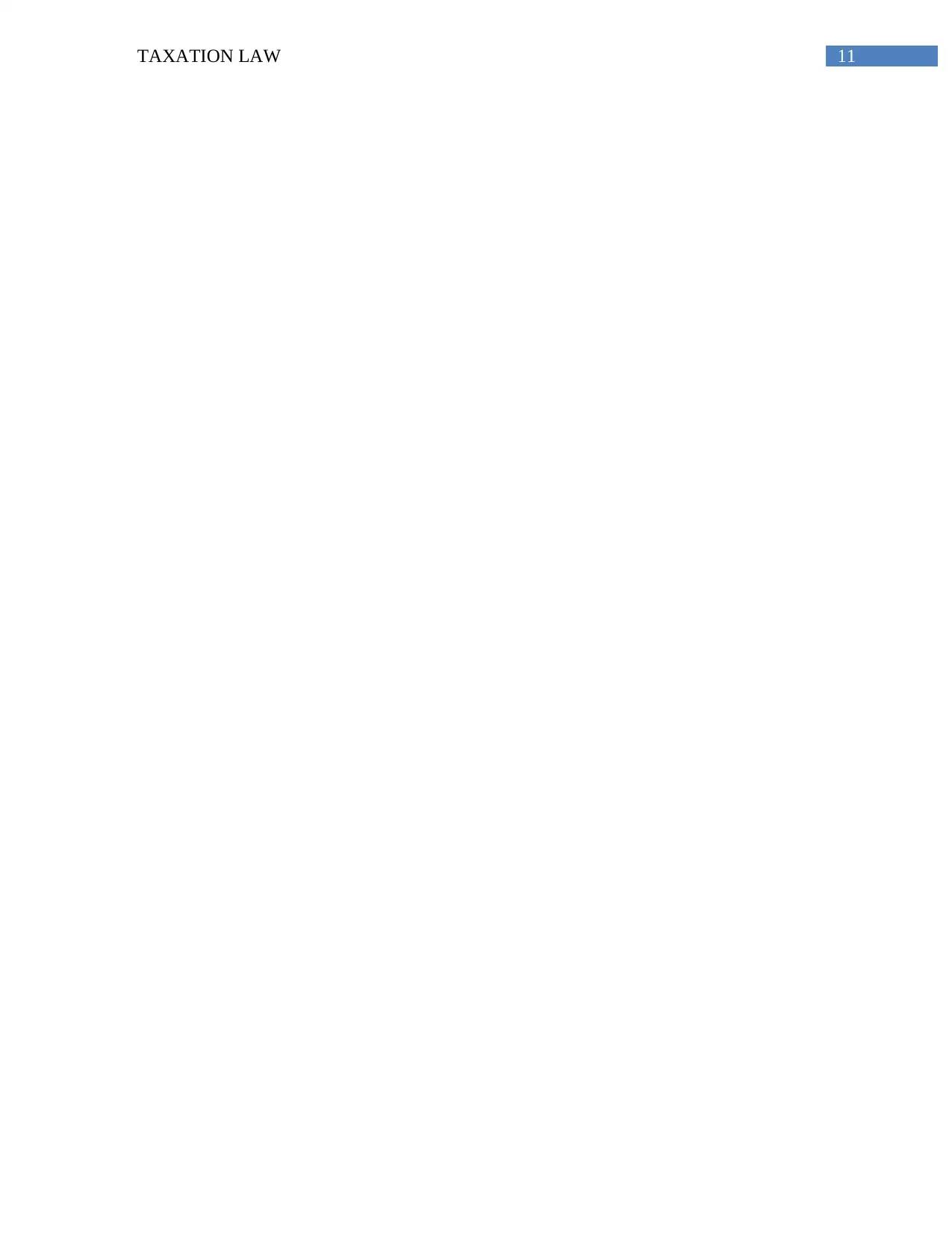
11TAXATION LAW
1 out of 12
Related Documents
Your All-in-One AI-Powered Toolkit for Academic Success.
+13062052269
info@desklib.com
Available 24*7 on WhatsApp / Email
![[object Object]](/_next/static/media/star-bottom.7253800d.svg)
Unlock your academic potential
© 2024 | Zucol Services PVT LTD | All rights reserved.





